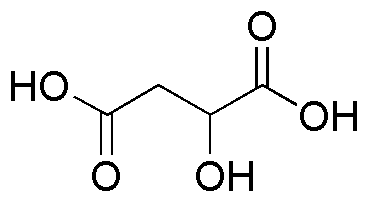DL-Malic acid is widely utilized in research focused on:
- Food and Beverage Industry: It serves as a natural acidulant and flavor enhancer in products like soft drinks and candies, improving taste while maintaining a low-calorie profile.
- Pharmaceuticals: This compound is used in drug formulations to enhance solubility and stability, making medications more effective and easier to administer.
- Cosmetics: DL-Malic acid is incorporated in skin care products for its exfoliating properties, helping to improve skin texture and promote a youthful appearance.
- Biotechnology: It plays a role in metabolic studies and fermentation processes, aiding researchers in understanding cellular metabolism and developing biofuels.
- Agriculture: Used as a chelating agent in fertilizers, it helps improve nutrient uptake in plants, leading to better growth and yield.
General Information
Properties
Safety and Regulations
Applications
DL-Malic acid is widely utilized in research focused on:
- Food and Beverage Industry: It serves as a natural acidulant and flavor enhancer in products like soft drinks and candies, improving taste while maintaining a low-calorie profile.
- Pharmaceuticals: This compound is used in drug formulations to enhance solubility and stability, making medications more effective and easier to administer.
- Cosmetics: DL-Malic acid is incorporated in skin care products for its exfoliating properties, helping to improve skin texture and promote a youthful appearance.
- Biotechnology: It plays a role in metabolic studies and fermentation processes, aiding researchers in understanding cellular metabolism and developing biofuels.
- Agriculture: Used as a chelating agent in fertilizers, it helps improve nutrient uptake in plants, leading to better growth and yield.
Documents
Safety Data Sheets (SDS)
The SDS provides comprehensive safety information on handling, storage, and disposal of the product.
Product Specification (PS)
The PS provides a comprehensive breakdown of the product’s properties, including chemical composition, physical state, purity, and storage requirements. It also details acceptable quality ranges and the product's intended applications.
Certificates of Analysis (COA)
Search for Certificates of Analysis (COA) by entering the products Lot Number. Lot and Batch Numbers can be found on a product’s label following the words ‘Lot’ or ‘Batch’.
*Catalog Number
*Lot Number
Certificates Of Origin (COO)
This COO confirms the country where the product was manufactured, and also details the materials and components used in it and whether it is derived from natural, synthetic, or other specific sources. This certificate may be required for customs, trade, and regulatory compliance.
*Catalog Number
*Lot Number
Safety Data Sheets (SDS)
The SDS provides comprehensive safety information on handling, storage, and disposal of the product.
DownloadProduct Specification (PS)
The PS provides a comprehensive breakdown of the product’s properties, including chemical composition, physical state, purity, and storage requirements. It also details acceptable quality ranges and the product's intended applications.
DownloadCertificates of Analysis (COA)
Search for Certificates of Analysis (COA) by entering the products Lot Number. Lot and Batch Numbers can be found on a product’s label following the words ‘Lot’ or ‘Batch’.
*Catalog Number
*Lot Number
Certificates Of Origin (COO)
This COO confirms the country where the product was manufactured, and also details the materials and components used in it and whether it is derived from natural, synthetic, or other specific sources. This certificate may be required for customs, trade, and regulatory compliance.


